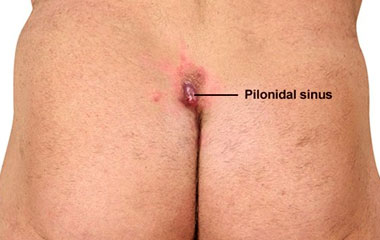hemalbhagat@hotmail.com
Get a Consultation
A pilonidal sinus (PNS) is a small hole or tunnel in the skin. It may fill with fluid or pus, causing the formation of a cyst or abscess. It occurs in the cleft at the top of the buttocks. A pilonidal cyst usually contains hair, dirt, and debris. It can cause severe pain and can often become infected. If it becomes infected, it may ooze pus and blood and have a foul odor.
A PNS is a condition that mostly affects men and is also common in young adults. It’s also more common in people who sit a lot, like cab drivers.

The exact cause of this condition isn’t known, but its cause is believed to be a combination of changing hormones (because it occurs after puberty), hair growth, and friction from clothes or from spending a long time sitting.
Activities that cause friction, like sitting, can force the hair growing in the area to burrow back under the skin. The body considers this hair foreign and launches an immune response against it, similar to how it would react when dealing with a splinter. This immune response forms the cyst around your hair. Sometimes a person may have multiple sinuses that connect under the skin.
You may not have any noticeable symptoms at first other than a small, dimple-like depression on the surface of your skin. However, once the depression becomes infected, it will quickly develop into a cyst (a closed sac filled with fluid) or an abscess (a swollen and inflamed tissue where pus collects).
The signs of an infection include:
Conservative treatment
If your case is diagnosed early on, you aren’t experiencing severe pain, and there’s no sign of inflammation, it’s likely that your doctor will prescribe a broad-spectrum antibiotic. A broad-spectrum antibiotic is an antibiotic that treats a wide range of bacteria. It’s important to realize that this won’t heal the sinus tract, but it will give you relief from the infection and discomfort. Your doctor will recommend that you get a follow-up exam, regularly remove hair or shave the site, and pay particular attention to hygiene.
Incision & Drainage
This procedure alleviates symptoms from an abscess, or a collection of pus inside the sinus. Before this procedure, your doctor will give you a local anesthetic. They will then use a scalpel to open the abscess. They will clean away any hair, blood, and pus from inside the abscess.
Your doctor will pack the wound with sterile dressing and allow it to heal from the inside out. The wound usually heals within four weeks, and people may require a definitive excision of sinus later on.
Surgery
If you have a recurring PNS or if you have more than one sinus tract, your doctor will recommend a surgical procedure.
Excision of sinus with flap surgery
In this procedure the surgeon does a wide bore local excision of the skin containing the sinus tract. The resulting cavity is left open to heal and fill in naturally from the bottom upwards. The wound is kept covered with a dressing.
Laser ablation of sinus cavity
This is a minimally invasive procedure done using the Leonardo laser. A small cut is made on the skin and all the pus is drained out. The entire sinus tract is then sealed with the laser fibre.
After surgery, your doctor will explain how to change the dressings and will recommend shaving the site to prevent hair from growing into the wound.
One should remember that recurrence rate is very high in Pilonidal sinus no matter what type of treatment is chosen as the positive reason is the hair on the back so the patient should always take care that he should keep his or her back shaven most of the time.